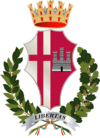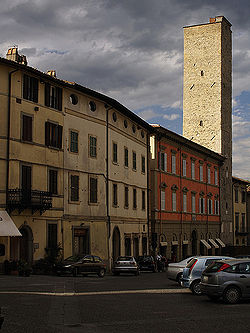- Città di Castello
-
Città di Castello — Comune — Comune di Città di Castello 
Coat of armsLocation of Città di Castello in Italy Coordinates: 43°27′39″N 12°14′38″E / 43.46083°N 12.24389°ECoordinates: 43°27′39″N 12°14′38″E / 43.46083°N 12.24389°E Country Italy Region Umbria Province Perugia Frazioni see list Government – Mayor Luciano Bacchetta (Democratic Party) Area – Total 387.53 km2 (149.6 sq mi) Elevation 288 m (945 ft) Population (30 April 2010) – Total 40,479 – Density 104.5/km2 (270.5/sq mi) Demonym Tifernati or Castellani Time zone CET (UTC+1) – Summer (DST) CEST (UTC+2) Postal code 06010, 06011, 06012, 06018 Dialing code 075 Patron saint Saint Florido Saint day November 13 Website Official website Città di Castello is a city and comune in the province of Perugia, in the northern part of the Umbria region of Italy. It is situated on a slope of the Apennines, on the flood plain of the river Tiber. The city is 56 km (35 mi) north of Perugia and 104 km (65 mi) south of Cesena on the S3bis. It is connected to the A1 highway by the SS 73 from Arezzo.
Contents
History
The town was founded by the Umbri tribes. The Romans knew it as Tifernum Tiberinum ("Tifernum on the Tiber")[1] or Civitas Tiberina. Just nearby, Pliny the Younger built his villa in Tuscis, which is identified with walls, mosaic floors and marble fragments surviving at a place now called Colle Plinio, the "Hill of Pliny". The town may have come into conflict with the Etruscans.[2]
In 550, Tifernum was largely destroyed during the Ostrogothic campaign by Fantalogus, at the orders of Totila. The town was subsequently rebuilt by its bishop, Floridus, around a castle, and renamed first Castrum Felicitatis and later Civitas Castelli. By the Donation of Pepin of the Frankish king Pepin the Short in 752, it went to the Holy See, though in practice it was disputed between the papacy, Perugia and Florence. It was ruled by the Vitelli family, even after Cesare Borgia attached the city more directly to the Holy See.
In subsequent centuries, it had various rulers, among them Pier Saccone Tarlati di Pietramala, brother of Guido, Bishop of Arezzo. Pier Saccone sold it in 1322 to Guido Alberto de' Guidi di Modigliana. In the later Middle Ages it was governed successively by the Guelphs and Ghibellines. In 1375, Città di Castello joined the insurrection of other cities of the States of the Church. Cardinal Robert of Geneva (later antipope as Clement VII), tried to capture it using Breton mercenaries, but was repulsed. Under Pope Martin V in 1420, it was taken by the condottiero Braccio da Montone. Later Niccolò Vitelli, aided by Florence and Milan, became absolute ruler or tiranno. Antonio da Sangallo the Younger built an extensive palace for the Vitelli family.
In 1474, Sixtus IV sent his nephew, Cardinal Giuliano della Rovere (later Julius II); after fruitless negotiations he laid siege to the city, but Vitelli did not surrender until he learned that the command of the army had been given to Duke Federico III da Montefeltro. The following year Vitelli tried unsuccesefully to recapture the city; fear of Cesare Borgia induced him to desist, since Cesare Borgia had his father strangled and Città di Castello added to the papal possessions.
Towards the end of the twentieth century, the city has seen a considerable expansion northwards toward San Giustino, with industrial parks tracking the river, railroad and main highway: the area produces farm machinery, textiles, ceramics and furnishings.
Main sights
The city is mostly built of brick, since the local sandstone erodes very rapidly. Its principal monuments include the medieval Palazzo Comunale and a tall thin tower, the Torre Comunale; and the Pinacoteca Comunale, an art museum with mostly Renaissance works, notable for its external decoration by Giorgio Vasari.
The much reworked cathedral, now mostly from the 18th century with an unfinished 17th century façade, has an altar-front (paliotto) of chased silver dating to the 12th century, and a crosier from the 15th. It also houses works by Niccolò Circignani, Rosso Fiorentino and Raffaellino del Colle. The bell tower is in Romanesque style (13th century). The Cathedral's museum is home to the Canoscio hoard, a set of Late Antique silver spoons and plates with Christian motifs, as well as a silvered altarpiece donated by Pope Celestine V in the 12th century, a Madonna by Pinturicchio (1486) and Angels by Giulio Romano.
The city has memorialized the abstract painter and sculptor Alberto Burri, who was born in Città di Castello, with the "Fondazione Palazzo Albizzini Collezione Burri" housing a large permanent museum of his works in the former Palazzo Albizzini.
Famous inhabitants
For persons from the city, see People from Città di Castello. In addition, the following are believed to have had a local connection, usually through long residence there:
- Pliny the Younger
- Pope Celestine II
- Monica Bellucci
- Vitellozzo Vitelli
- Alberto Burri
- Salvatore Sciarrino
Frazioni
Antirata, Astucci, Badiali, Badia Petroia, Barzotti, Baucca, San Martino d'Upò, Belvedere, Bisacchi, Bonsciano, Caifirenze, Candeggio, Canoscio, Capitana, Celle, Cerbara, Cinquemiglia, Colcello, Coldipozzo, Cornetto, Croce di Castiglione, Fabbrecce, Fiume, Fraccano, Grumale, Lerchi, Lugnano, Madonna di Canoscio, Marchigliano, Montemaggiore, Monte Ruperto, Morra, Muccignano, Nuvole, Palazzone, Petrelle, Piosina, Promano, Riosecco, Roccagnano, Ronti, Rovigliano, San Leo Bastia, San Biagio del Cornetto, San Lorenzo Bibbiana, San Maiano, San Martin Pereto, San Martino di Castelvecchio, San Pietro a Monte, San Secondo, Santa Lucia, Scalocchio, Seripole, Terme di Fontecchio, Titta,Trestina, Uppiano, Userna, Userna Bassa, Valdipetrina, Vallurbana, Vingone, Volterrano.
Twin towns
 Joué-lès-Tours, France, since 1991
Joué-lès-Tours, France, since 1991 Sighişoara, Romania
Sighişoara, Romania
Notes
- ^ The name distinguished it from Tifernum Mataurense and Tifernum on the Sannio. (Guida d'Italia)
- ^ Pliny the Elder, Book III, chap. 19, paragraphs 112-113. Also at wikisource latina
Sources and external links
- Youtube.com
 This article incorporates text from a publication now in the public domain: Herbermann, Charles, ed (1913). Catholic Encyclopedia. Robert Appleton Company. Newadvent.org
This article incorporates text from a publication now in the public domain: Herbermann, Charles, ed (1913). Catholic Encyclopedia. Robert Appleton Company. Newadvent.org- Touring Club Italiano, 1966. Guida d'Italia: Umbria pp136–42.
- Official homepage (in Italian) (in English)
- Bill Thayer's site
- Basic information at Umbria Online (in English)
- Umbria Travel: Città di Castello
- Bella Umbria - Città di Castello (in English)
Umbria · Comuni of the Province of Perugia Assisi · Bastia Umbra · Bettona · Bevagna · Campello sul Clitunno · Cannara · Cascia · Castel Ritaldi · Castiglione del Lago · Cerreto di Spoleto · Citerna · Città della Pieve · Città di Castello · Collazzone · Corciano · Costacciaro · Deruta · Foligno · Fossato di Vico · Fratta Todina · Giano dell'Umbria · Gualdo Cattaneo · Gualdo Tadino · Gubbio · Lisciano Niccone · Magione · Marsciano · Massa Martana · Monte Castello di Vibio · Monte Santa Maria Tiberina · Montefalco · Monteleone di Spoleto · Montone · Nocera Umbra · Norcia · Paciano · Panicale · Passignano sul Trasimeno · Perugia · Piegaro · Pietralunga · Poggiodomo · Preci · San Giustino · Sant'Anatolia di Narco · Scheggia e Pascelupo · Scheggino · Sellano · Sigillo · Spello · Spoleto · Todi · Torgiano · Trevi · Tuoro sul Trasimeno · Umbertide · Valfabbrica · Vallo di Nera · ValtopinaCategories:- Cities and towns in Umbria
- Communes of the Province of Perugia
- Roman sites of Umbria
Wikimedia Foundation. 2010.


